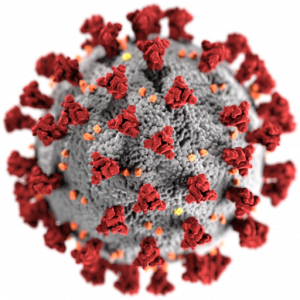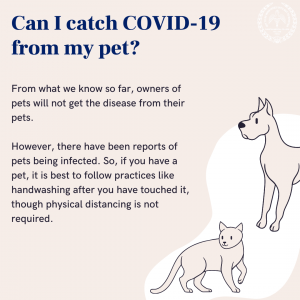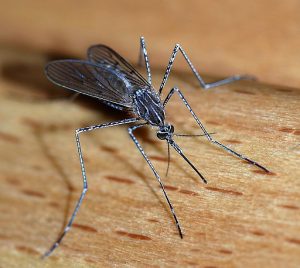Coronaviruses are a large family of viruses which may cause illness in animals or humans. In humans, several coronaviruses are known to cause respiratory infections ranging from the common cold to more severe diseases such as Middle East Respiratory Syndrome (MERS) and Severe Acute Respiratory Syndrome (SARS). The most recently discovered coronavirus, referred to as SARS-CoV-2 causes coronavirus disease or COVID-19.(1)

COVID-19 is an infectious disease caused by a coronavirus which is presumed to have crossed over from animals to humans recently. Currently, human to human transmission has helped the virus to spread leading to a pandemic situation. (1)
The most common symptoms of COVID-19 are fever, tiredness, and dry cough. Some patients may have aches and pains, nasal congestion, runny nose, sore throat or diarrhoea. These symptoms are usually mild and begin gradually. Some people become infected but do not develop any symptoms and remain asymptomatic. Most people (~ 80-90%) recover from the disease without needing hospitalisation.
Around one1 out of every six people who gets COVID-19 becomes seriously ill and develops difficulty in breathing. Older people, and those with underlying medical problems like high blood pressure, heart problems or diabetes, are more likely to develop serious illness. People with fever, cough and difficulty breathing should seek medical attention (1).
The new coronavirus is a respiratory virus which spreads primarily through droplets generated when an infected person coughs or sneezes, or through droplets of saliva or discharge from the nose (1,2).
Person-to-person spread
The virus spreads mainly from person-to-person through respiratory droplets produced when an infected person coughs, sneezes, or talks
Spread from contact with contaminated surfaces or objects
The virus is highly transmissible; though not a primary mode of infection, it can spread if an individual touches surfaces or objects that has the virus on it and then touches their mouth, nose, or their eyes. (3,4,5,6)
Coronaviruses are viruses that circulate among animals, with some of them also known to infect humans. We do not know the exact source of the current outbreak of coronavirus disease 2019 (COVID-19). The first infections were linked to a live animal market, but the virus is now primarily spreading from person to person (6,7,8).

The number of cases of COVID-19 being reported in our country is rising as the virus spreads across the nation. The rise also coincides with increased laboratory testing and reporting across the country. The growing number of cases reflects, in part, the high transmissibility of the virus and the absolute need for physical distancing in the country. Detailed information that is emerging from the various states will allow us to identify hotspots, track the size and scope of the outbreak in each of these regions and strengthen our efforts to prevent a further spread (2).
The virus that causes COVID-19 can spread from person-to-person. People when showing all the symptoms (the sickest) are thought to be the most contagious. It is recommended that these patients be isolated either in a hospital or at home until they are better or no longer pose a risk of infection to others. The virus has also been detected in asymptomatic persons, who are not unwell themselves but can be a source of spread of the virus (1,8,9,10).
No. Quarantine is a state, period or place of isolation in which people or animals that have arrived from elsewhere or been exposed to infectious or contagious disease are placed, in order to prevent a possible spread of that disease. Quarantine is usually established for the incubation period of the communicable disease.
For COVID-19, the period of quarantine is 14 to 28 days from the last date of exposure because the incubation period for this virus is two to 14 days. Someone who has been released from COVID-19 quarantine is not considered a risk for spreading the virus to others because they have not developed illness during the incubation period (1).
No, the transmission of COVID -19 through food is not reported; it mostly spreads from person to person through droplets from coughing and sneezing. It is possible that the virus can settle on the surfaces of food containers and then spread to the person who comes into contact with them. Therefore, it is important to wash hands as often as possible after touching any surface that can be possibly contaminated. However, it is less likely for the virus to spread from refrigerated and frozen, packaged food (1,9,10, 11).
No. COVID-19 does not transmit through food. There is no evidence suggesting the same. However, hygiene has to be maintained by washing cooking counters and while handling food. A sick person should avoid preparing food (1,3,4).
Unascertained. Unlike earlier outbreaks like common flu which are seasonal, the spread of COVID 19 based on temperature is not yet known (1). Though few experiments on SARS-CoV-2 reported that increasing temperature inactivates the virus (5), there is no evidence that warm weather will stop the virus.
Community spread also known as community transmission is when people have been infected with the virus without knowledge of direct contact with someone who has the same infection. Health officials are not sure of how or where they became infected (6). This is the third stage of the disease transmission, making it difficult to trace the source of infection; Infection is passed on in public; Once community transmission begins, it becomes difficult to contain the disease and to stop the chain of transmission. (7)
At present, there is no direct data for a temperature-based cutoff for inactivation of COVID-19 virus. It is not yet known whether weather and temperature affect the spread of COVID-19. Generally other coronaviruses survive for shorter periods at higher temperatures and higher humidity than in cooler or dryer environments. (1,10,11, 12)
Current research links COVID-19 to certain types of bat as the original source, but does not exclude the involvement of other animals. Though mosquitoes and ticks are not known to transmit the virus, it is advisable to protect yourself, by following prevalent safety measures against mosquitoes and ticks (2,8,9).

No – respiratory droplets are found to be the most common mode of coronavirus transmission (10, 11). The virus can remain in these droplets for 4-5 hours.
There is no specific treatment or vaccine for this disease. Healthcare providers are mostly using a symptomatic approach, meaning they treat the symptoms rather than target the virus, and provide supportive care (e.g. oxygen therapy, fluid management) for infected persons, which can be highly effective.
In severe and critically ill patients, a number of drugs are being tried to target the virus, but the use of these need to be more carefully assessed in randomized controlled trials. Several clinical trials are ongoing to assess their effectiveness. As this is a new virus, no vaccine is currently available. Although work on a vaccine has already started by several research groups and pharmaceutical companies worldwide, it may be months to more than a year before a vaccine has been tested and is ready for use in humans (8).
There are two vaccines available in India - COVISHIELD and COVAXIN - licensed for Emergency use, by the Drugs Controller General of India (DCGI).
The development of vaccines take time. Several pharmaceutical companies and research laboratories are working on vaccine candidates. It will, however, take months or years before any vaccine can be widely used, as it needs to undergo extensive testing in clinical trials to determine its safety and efficacy. These clinical trials are an essential precursor to regulatory approval and usually take place in three phases. The first, involving a few dozen healthy volunteers, tests the vaccine for safety, monitoring for adverse effects. The second, involving several hundred people, usually in a part of the world badly affected by the disease, looks at how effective the vaccine is in the field, and the third does the same in several thousand people.
No. Even though both are coronavirus, COVID-19 is not the same as SARS. SARS was not reported after its outbreak after 2003 (9). COVID-19 virus also referred to as SARS-CoV-2, shares lots of similarity to the SARS virus.
Current evidence suggests that the COVID-19 virus first emerged from an animal source.(11) However, the virus is now being transmitted from person-to-person. Despite the low chance of transmission from other animal sources to stay safe it might be best to avoid visiting live animal markets, avoid direct contact with animals and surfaces in contact with animals.
When possible, people who are sick with COVID-19 should avoid close contact with their pets and have another member of their household care for their animals. If they must look after their pet, they should maintain good hygiene practices and wear a face mask if possible. Animals belonging to owners infected with COVID-19 should be kept indoors as much as possible and contact with those pets should be avoided as much as possible (12).
Incubation period is the time from contracting a virus to when the symptoms start. Currently, according to the Centers for Disease Control and Prevention (CDC), USA, the incubation period for the novel coronavirus is 5-6 days ranging from 2-14 days after exposure. (13)
COVID-19 was found to be more stable on plastic and stainless steel than on copper and cardboard, and viable virus was detected up to 72 hours after application to these surfaces. On copper, no viable SARS-CoV-2 was measured after 4 hours. On cardboard, no viable SARS-CoV-2 was measured after 24 hours (14).
NOTE: These experiments were conducted in a controlled laboratory environment.
The likelihood of an infected person contaminating commercial goods is low and the risk of transmission of the virus that causes COVID-19 from a package that has been moved, travelled, and exposed to different conditions and temperature is also low. Currently, there is no evidence of food or food packaging being associated with transmission of COVID-19. (2,9,15).
Immediate medical attention should be sought if any of the emergency warning signs develop:
• Acute Respiratory Distress Syndrome (ARDS)
• Acute Respiratory failure
• Cardiac Complications – vascular inflammation, cardiac arrhythmias, myocarditis, acute cardiac injury
• Acute Liver injury
• Cytokine Release Syndrome
• Septic Shock
• Disseminated Intravascular Coagulation
• Secondary infection
• Acute Kidney Injury
• Pancreatic Injury
• Neurologic Complications
• Rhabdomyolysis as a late complication
• Pregnancy related complications
Not everyone needs to be tested for COVID-19. A medical practioner that you seek help from, will be able to decide if you need to be tested based on your symptoms. The guidelines drawn by the Indian Council of Medical Research needs to be adhered to. Testing approaches may be altered periodically based on the prevailing situation at national and local level (1,8)
Note : Please refer to ICMR website (https://www.icmr.nic.in/content/covid-19) for current testing strategy in India.
The process and locations for testing vary from place to place. A list of laboratories that are approved for testing is on the ICMR website. If you are experiencing symptoms of COVID-19, you should immediately isolate yourself from others. Contact your state or local government department for more information, or reach out for medical help (1,12)
A negative result means that the virus that causes COVID-19 was not found in the person’s sample. In the early stages of infection, it is possible the virus will not be detected and hence a person can test negative and later turn positive for COVID-19. For COVID-19, a negative test result for a sample collected while a person has symptoms likely means that the COVID-19 virus is not causing their current illness (1). However, a repeat test will be required to ascertain the fact and the second test will also have to be negative.
A COVID-19 infection has the same signs and symptoms as the common flu and you can only differentiate them through laboratory testing to determine the virus type (12)
The risk depends on where you are and more specifically, whether there is a COVID-19 outbreak unfolding there. For most people in most locations the risk of catching COVID-19 is still low. However, there are now places around the world (cities or areas) where the disease is spreading rapidly. For people living in, or visiting, these areas the risk of contracting COVID-19 is higher.
Governments and health authorities are active in their efforts of contact tracing, isolating and limiting transmission of COVID-19, every time a new case is identified. Be sure to comply with any local restrictions on travel/ movement and follow all rules of social distancing. Cooperating with disease control efforts will reduce your risk of contracting or transmitting the virus.
(Source: https://www.ecdc.europa.eu/en/covid-19/questions-answers)
Influenza and the virus that causes COVID-19 are two very different viruses and the seasonal influenza vaccine will not protect against COVID-19
Based on the data available so far, the high-risk groups are the elderly people (above 60 years of age), and people with pre-existing medical conditions such as cancer, chronic lung disease, moderate to severe asthma, heart disease, chronic kidney disease on dialysis, chronic liver diseases, diabetes and those who are immune-compromised (1,4,6,8,9,12,20,21). There is no evidence available to date that indicates children and pregnant women are at high risk of COVID-19 (4,8).
The people who are at higher risk to develop serious illness due to COVID-19 should try to stay home as far as possible so as to avoid exposure and to follow the hygiene protocols and to maintain social distancing protocols prescribed (1,4). The family members of those who are at high risk are requested to avoid contacts with other people as far as possible. The high risk group people should watch out for symptoms and signs of illness and should contact a doctor immediately (1). Those who are taking medications for chronic conditions like hypertension, asthma etc. should consult their physician before taking any decisions about stop taking such medications or changing the treatment plan (8,22).
The people with chronic lung conditions were considered to be at high risk because they can develop respiratory infection ultimately leading to pneumonia and acute respiratory disease. Similarly, other disease conditions mentioned above can put people at high risk compared to others in the population (23,24).
Severe illness means how much impact the disease has on your body’s function (1). In context of COVID-19 severe illness typically includes patients experiencing illness as explained in question 25
Disability by itself does not amount to higher risk for becoming infected with or having severe illness from COVID-19. However, some of them with physical limitations or other disabilities might be at a higher risk of getting infected due to their underlying medical condition (1,25).
The following disability types are considered to possess higher risk of getting infected or having unrecognized illness (1,25)